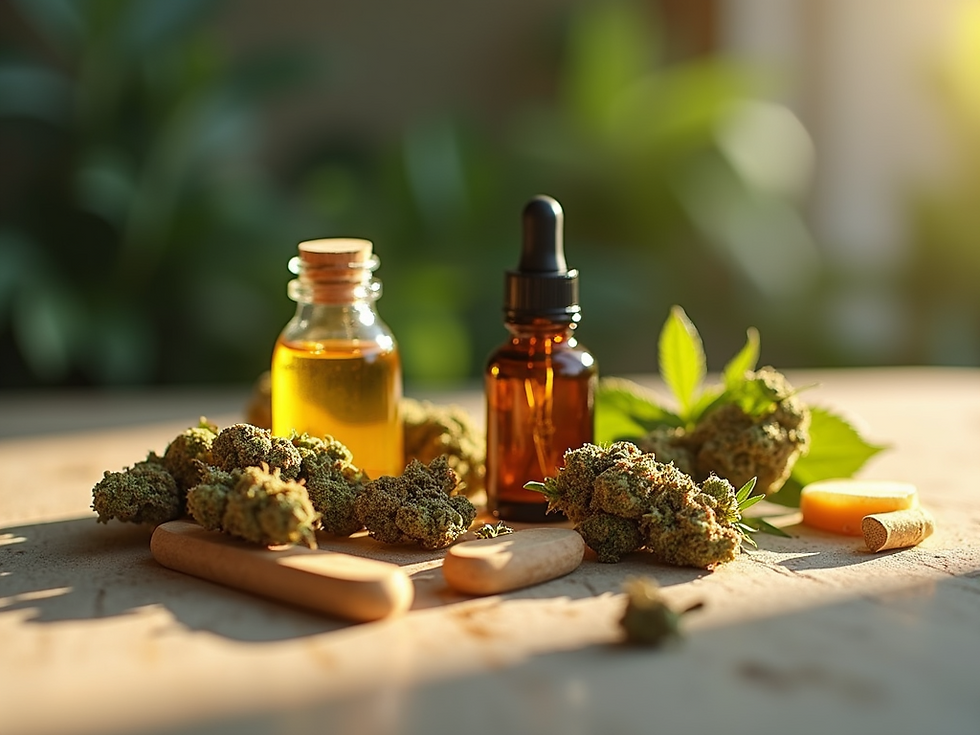Beyond THC and CBD: Exploring Minor Cannabinoids and Their Uses
- Courtney Beaupre
- Oct 19
- 3 min read
When most people think about cannabis, two compounds usually come to mind: THC (tetrahydrocannabinol), the psychoactive component that produces a high, and CBD (cannabidiol), the non-intoxicating compound celebrated for its therapeutic potential. But did you know that the cannabis plant produces over 100 different cannabinoids, many of which are considered minor cannabinoids?

Though they’re found in much smaller quantities, minor cannabinoids are stepping into the spotlight as researchers uncover their unique benefits. These compounds might not be as famous as THC or CBD, but they could hold the key to more targeted and effective therapies.
Let’s dive into some of the most promising minor cannabinoids and what science currently says about their potential uses.
CBG (Cannabigerol) – The “Mother of All Cannabinoids”
CBG is often referred to as the precursor or “stem cell” cannabinoid because it's the compound from which other cannabinoids are synthesized.
Potential Benefits:
Anti-inflammatory: May help reduce inflammation in conditions like IBD (inflammatory bowel disease).
Neuroprotective: Shows promise in protecting neurons in diseases like Huntington’s.
Antibacterial: Especially effective against resistant bacteria like MRSA.
Popular Uses: Focus and energy support, gut health, and skin care formulations.
CBN (Cannabinol) – The Sleepy Cannabinoid
CBN is a breakdown product of THC, usually formed when cannabis ages. It has very mild psychoactive effects, if any.
Potential Benefits:
Sedative: Often marketed for its sleep-enhancing effects.
Pain relief: May help reduce chronic pain and inflammation.
Appetite stimulant: Unlike CBD, it could increase appetite, similar to THC.
Popular Uses: Sleep aids, nighttime tinctures, and calming edibles.
CBC (Cannabichromene) – The Mood Booster
CBC is non-intoxicating and interacts with receptors in the body that are linked to pain perception and mood regulation.
Potential Benefits:
Anti-depressant: May work synergistically with other cannabinoids to improve mood.
Anti-inflammatory: Useful in treating pain and swelling.
Anti-acne: May reduce sebaceous gland activity and help manage breakouts.
Popular Uses: Skin care, mood enhancement, and anti-inflammatory blends.
THCV (Tetrahydrocannabivarin)
THCV is structurally similar to THC but has different effects and doesn’t typically cause a high at lower doses.
Potential Benefits:
Appetite suppressant: May help with weight management.
Blood sugar regulation: Early research suggests it may aid in managing type 2 diabetes.
Energy & focus: Users report a stimulating, clear-headed experience.
Popular Uses: Weight-loss formulas, pre-workout supplements, and focus-enhancing products.
CBDV (Cannabidivarin) – The Neuroprotective Ally
CBDV is closely related to CBD and is being studied for its impact on neurological and developmental conditions.
Potential Benefits:
Seizure reduction: Shows promise in treating epilepsy, particularly in children.
Autism spectrum disorder (ASD): Early trials are investigating its role in managing irritability and behavior.
Anti-nausea: May help with nausea and vomiting, especially from chemotherapy.
Popular Uses: Pediatric neurological support, anti-nausea formulations, and wellness products.
Why Minor Cannabinoids Matter
The entourage effect — the theory that cannabinoids and terpenes work better together than alone — suggests that even small amounts of minor cannabinoids can enhance the overall effectiveness of a product. As research continues, we may discover that these lesser-known compounds offer highly targeted relief for a variety of conditions, from insomnia and anxiety to chronic pain and inflammation.
Final Thoughts
We’re still in the early stages of fully understanding minor cannabinoids, but the potential is exciting. With the legalization of hemp and growing interest in plant-based wellness, we can expect to see more products that go beyond THC and CBD.
Whether you're a patient, wellness advocate, or just a curious consumer, keeping an eye on minor cannabinoids is a smart move. They might be “minor” in concentration, but their impact on health and wellness could be major.
Disclaimer: This blog post is for informational purposes only and is not intended as medical advice. Always consult with a healthcare professional before starting any new supplement or treatment.
.png)
Comments